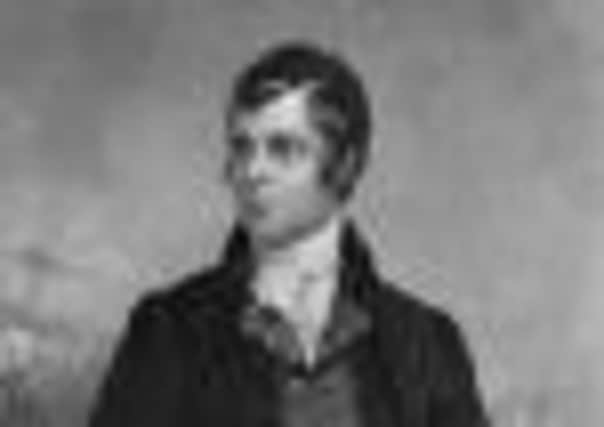A beginner’s guide to Burns Night


Burns Night is celebrated on January 25 every year, and is widely considered to be Scotland’s second national day alongside St Andrews Day. It celebrates Scotland’s most famous and revered national poet, Robert Burns, whose most best-known works form part of the fabric of Scottish life.
About Robert Burns
Robert Burns (1759-1796) was born in Alloway, near the town of Ayr. Born into a farming family struggling to eke out a living, Burns’ early life was hardly prosperous, but he was nevertheless given a reasonable education by his parents William and Agnes. His love for literature and song soon became apparent as he sought respite from the daily toil of the family farm, while also growing fond of alcohol and the opposite sex.
Advertisement
Hide AdDespite fathering twins with wife Jean Armour, he nearly emigrated to the West Indies, only changing his mind when his poetry became recognised by his contemporaries in Scotland. It was shortly after this period that Burns had already published some of his most famous works, including To a Louse and Highland Mary. A move to Edinburgh saw him accelerate his creative output at the same speed as his growing fondness for illicit romantic liaisons and late nights at the bar.
A move to Dumfries followed in 1789 where he became an excise officer and rekindled his relationship with Jean Armour. His failing health, brought on by alcoholism and the after-effects of long periods of physical labour in early life, contributed to his death at the age of 37. By the time of his death, the poet’s works were already widely read and celebrated, and have only grown in influence across the world since.
Burns Night
Burns Night can be small, informal occasions, or they can be large-scale formal dining experiences. In either case, the meal traditionally served to guests consists of haggis, neeps and tatties (that’s haggis, turnips and potatoes). Haggis is a dish made of beef suet, beef fat (although some will prefer lamb), lamb pluck (heart and liver), oatmeal, onions and plenty of spices, all wrapped in sheep’s stomach.
Perhaps not the most appetising dish on paper to anyone unfamiliar with its unique charms - but, as the saying goes, don’t knock it until you try it.
Address to a Haggis
One of the most notable aspects of Burns Night is the recital of a poem written by the bard in 1786, Address to a Haggis. It is traditionally recited before the meal by the head of the table, who holds a knife over the haggis before cutting into it at the end of the poem. The poem in full is provided below: if you’re planning to throw your own Burns soiree, now’s a good time to get practicing.
Fair fa’ your honest, sonsie face,
Great chieftain o’ the pudding-race!
Aboon them a’ ye tak your place,
Painch, tripe, or thairm:
Weel are ye wordy o’a grace
As lang’s my arm.
The groaning trencher there ye fill,
Your hurdies like a distant hill,
Your pin wad help to mend a mill
In time o’need,
While thro’ your pores the dews distil
Like amber bead.
His knife see rustic Labour dight,
An’ cut you up wi’ ready sleight,
Trenching your gushing entrails bright,
Like ony ditch;
And then, O what a glorious
sight,
Warm-reekin’, rich!
Then, horn for horn, they stretch an’ strive:
Deil tak the hindmost! on they drive,
Till a’ their weel-swall’d kytes belyve
Are bent like drums;
Then auld Guidman, maist like to rive,
Bethankit! hums.
Is there that owre his French ragout
Or olio that wad staw a sow,
Or fricassee wad make her spew
Wi’ perfect sconner,
Looks down wi’ sneering, scornfu’ view
On sic a dinner?
Poor devil! see him owre his trash,
As feckless as wither’d rash,
His spindle shank, a guid whip-lash;
His nieve a nit;
Thro’ bloody flood or field to dash,
O how unfit!
But mark the Rustic, haggis-fed,
The trembling earth resounds his tread.
Clap in his walie nieve a blade,
He’ll mak it whissle;
An’ legs an’ arms, an’ heads will sned,
Like taps o’ thrissle.
Ye Pow’rs, wha mak mankind your care,
And dish them out their bill o’ fare,
Auld Scotland wants nae skinking ware
That jaups in luggies;
But, if ye wish her gratefu’ prayer
Gie her a haggis!
Burns Night recipe
Read a step-by-step guide by chef and Scotland on Sunday food writer Tom Kitchin on how to makehaggis, neeps and tatties
Robert Burns factfile
Advertisement
Hide Ad• Born: January 25, 1759, Alloway. Burns Night is celebrated on the bard’s birthday every year
• As well as being a poet, Robert Burns was a farmer and exciseman. He also nearly took up a job as a bookkeeper in Jamaica, and had previously held a short-lived ambition to be a flax-dresser
Advertisement
Hide Ad• Burns, famous for numerous love affairs, fathered a total of 12 children; the poet has over 600 living descendants
• One of Robert Burns’ most famous works, Auld Lang Syne, is recognised by the Guinness Book of World Records as one of the top three most sung songs in the English language alongside ‘Happy Birthday’ and ‘For he’s a jolly good fellow’
• An STV poll in 2009 voted Robert Burns as the Greatest Scot of all time, beating William Wallace